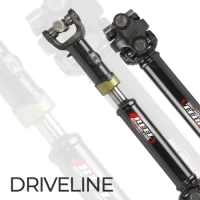Save with our Tax Refund Sale - Shop Now
Heat Shields | Wraps
ABOUT HEAT SHEILD/WRAPS
The primary function of the exhaust heat shield is to prevent the exhaust's extreme heat from igniting a fire or penetrating the cabin and causing discomfort to the vehicle's occupants. It is not advised to remove the exhaust heat shield as doing so poses a fire hazard. The paint on the automobile's exterior will burn and flake off. Additionally, some plastic or flammable components, such as grass or components underneath your vehicle, may cause a fire. Also, if the heat shield is removed, the exhaust heat will transfer into the cabin. This occurs because exhaust pipe temperatures are extremely high. Moreover, if your car is running rich, some of the unburned fuel may ignite in the catalytic converter, which can also become extremely hot. Exhaust heat shields are typically constructed from high-strength sheets of aluminum and a ceramic thermal barrier to further enhance the heat shield's thermal capabilities.
WHY USE HEAT SHEILD/WRAPS?
Exhaust heat shields are required to maintain a cool cabin and prevent fire hazards in the surrounding environment. These days, automobile exhausts are significantly hotter than they were 30 or 40 years ago, especially on vehicles with high performance. During the summer's hottest days, car exhaust can reach extremely high temperatures that can affect the comfort of the vehicle's occupants and even start a fire if parked beneath grass, trees, or plastic. In addition, the exhausts are becoming so hot that they could easily melt nearby components. There is a great deal of plastic in automobiles today. In the worst-case scenario, if the heat from the exhaust reaches these plastic pieces, they could melt or even catch fire. Exhaust heat shields protect you and your vehicle from extremely hot components such as the catalytic converters (CATs) and exhaust pipes. They should not be removed. You may need to tighten or replace them if they rattle.
HEAT SHIELD/WRAP TYPES
If you want to replace your standard heat shield plate, titanium and stainless steel are likely the best materials for heat shields. The high melting point of titanium is a benefit of the material. Titanium can withstand high temperatures without melting. Also, prevent the heat from entering your cabin. However, it can be quite costly to acquire because it is so expensive. Stainless steel is a replacement for titanium. If you want to acquire an aftermarket heat shield, stainless steel is also a good option. The most important features are that it does not rust and that it has good thermal properties.
If you choose to use a heat wrap instead, fiberglass or titanium would be the best options. Since fiberglass materials are inexpensive, extremely durable, and non-combustible, they are one of the best options available.
HEAT SHEILD/WRAPS IN VIVID RACING
It is rarely easy to find the ideal aftermarket component. We completely understand, and we are here to assist you in locating the correct heat shield/wraps and upgrades for your particular application. Our passion is assisting customers in creating their dream vehicles. Vivid Racing guarantees that their products meet the quality, comfort, and strength requirements of their customers.

.jpeg?q=90&p=thumb&w=200&h=200)











.jpeg?q=90&p=thumb&w=40&h=40) Brakes
Brakes  Driveline
Driveline  Electronics
Electronics  Handlebars & Controls
Handlebars & Controls  Package Deals
Package Deals  Wheel Accessories
Wheel Accessories  Wheels by Vehicle
Wheels by Vehicle  Tools and Maintenance
Tools and Maintenance  Universal & Repair
Universal & Repair  Vivid Racing Gear
Vivid Racing Gear 